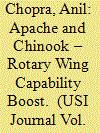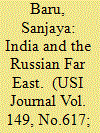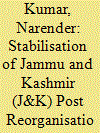|
|
|
Sort Order |
|
|
|
Items / Page
|
|
|
|
|
|
|
| Srl | Item |
| 1 |
ID:
169701


|
|
|
|
|
| Summary/Abstract |
Indian Air Force (IAF) and Indian Army (IA) will soon have formidable attack helicopter capability and will use for Suppression of Enemy Air Defences (SEAD) / Destruction of Enemy Air Defences (DEAD), Counter Air, Interdiction at varying depths inside enemy territory, Combat Search and Rescue (CSAR), etc. in furtherance of both air and ground battles. It would act as a tremendous force-multiplier at the point of decision, when required. Indigenous helicopters have taken reasonable shape but are held up due to delayed decision on weapons. Addition of the Chinook, Apache, the Rudra and MH 60 Romeo Seahawk helicopters will give a massive boost to the capability. Rotary wing fleet will continue to remain a very significant fleet both, in war and peace.
|
|
|
|
|
|
|
|
|
|
|
|
|
|
|
|
| 2 |
ID:
169695


|
|
|
|
|
| Summary/Abstract |
China, our main adversary, has moved closer to superpower status and has embarked on a military expansion by embracing high end disruptive technologies. It seeks parity with the United States of America (USA). It’s military technology and capability building plan is generally outlined in the recently released White Paper titled ‘China’s National Defence in the New Era’. Analysis indicates that the plan, though credible, has issues and will hit implementation roadblocks. On the other hand, India’s military strides have lagged in scale, pace, consistency and content. There is a military technology and capability gap opening between both nations in China’s favour. However, it is to be understood that India needs to possess only such ability which deters China from any misadventure. It is, therefore, very important that the military technological abilities of both nations be compared, in various military domains, to identify the gaps. These gaps must be seen in the context of the Sino Indian military geography. Further, an examination is necessary as to what are India’s options to bridge these gaps. It clearly emerges that due to the current slowdown in China, India has a time window to narrow the gaps provided it gets its act right, reforms its procurement process, starts harnessing its potential in disruptive technologies and most importantly, it is able fund the process adequately.
|
|
|
|
|
|
|
|
|
|
|
|
|
|
|
|
| 3 |
ID:
169697


|
|
|
|
|
| Summary/Abstract |
Jeremy Friedman, in a Harvard Business School case study, analyses as to who will be the world hegemon in future, as China becomes the largest economy in the world by 2030 according to various experts. German Foreign Minister expects China to “put its stamp on the world”. Prof. Rawi Abdelal of Harvard Business School, studying the above case questions Chinese capabilities to become the world hegemon in view of its autocratic leadership. However, if several data points are examined globally, increasingly China is seen to flex its muscles worldwide. It boasts of being the largest factory of the world and gives enormous indications of dominating this universe with economics, technology and demographics.
|
|
|
|
|
|
|
|
|
|
|
|
|
|
|
|
| 4 |
ID:
169703


|
|
|
|
|
| Summary/Abstract |
Nepal’s relations with its neighbours are taking a new trajectory. It is coming out of its landlocked status and taking upon itself the role of a bridge between India and China. During his visit to China in June 2018, Prime Minister KP Oli had said “We believe that Nepal can serve as a bridge between our two neighbours. In fact, we want to move from the state of a land-locked to a land-linked country through the development of adequate cross-border connectivity. Our friendship with both our neighbours places us in an advantageous position to realise this goal”.1 Oli’s statement surmises changes in Nepal’s foreign policy with its neighbours in a nutshell. The statement isn’t new on the neighbourhood relationship. In the recent past, previous prime ministers and ambassadors have made similar statements. Gone are the days of special relationship with India or the policy of balancing one against the other. The new emphasis is on connectivity and economic development. By this, Nepal is trying to redefine its foreign policy. In this article the term foreign policy is used in a limited sense of relations with Nepal’s neighbours.
|
|
|
|
|
|
|
|
|
|
|
|
|
|
|
|
| 5 |
ID:
169696


|
|
|
|
|
| Summary/Abstract |
Prime Minister Narendra Modi was the Chief Guest at the fifth meeting of the Eastern Economic Forum (EEF) held at Vladivostok, Russia in early September 2019. The Prime Minister’s participation in this meeting underscored India’s growing interest in building closer economic ties with the Russian Far East. India and Russia have long shared geopolitical perspectives on the balance of power across Eurasia. In the post-Cold War era, both turned their attention to the West. However, over the past decade India has pursued a “Look East Policy”, seeking to regain its political and economic influence in South-east Asia and building new strategic partnerships with East Asian powers like Japan and South Korea. Russia’s ‘pivot to the East’ and India’s move from ‘Look East’ to ‘Act East’ have created a new framework for closer India-Russia geo-economic and geopolitical relations.
|
|
|
|
|
|
|
|
|
|
|
|
|
|
|
|
| 6 |
ID:
169694


|
|
|
|
|
| Summary/Abstract |
The concept of deterrence is undergoing transformation in the emerging multi polar and multi nuclear world. The democratic world order and international institutions are being challenged, leading to a dynamic international security environment, where strategic balancing by even the global powers has become the norm. This has resulted in 24 X 7 Multi Domain Operations (MDO), where the military dimension is but one of the verticals albeit a decisive one. Applied effectively, deterrence discourages an adversary from pursuing an undesirable action. It works by changing the adversary’s calculation of costs, benefits and risks.
|
|
|
|
|
|
|
|
|
|
|
|
|
|
|
|
| 7 |
ID:
169702


|
|
|
|
|
| Summary/Abstract |
For decades military strategists have studied and evolved the ‘Principles of War’. Drawn from the long history of armed conflicts, these guidelines encapsulate the things that often lead to battle field successes. They reflect the accumulated wisdom of conventional war fighting. In this regard, some authors have said that cyberwar is also the continuation of kinetic war by other means. However, it is not; the two are quite different. One might say that they are checkers and chess – which only look the same because their terrain is the same and some of the pieces have the same name. It is, therefore, a great challenge to those military and cyber security experts who apply the rules of conventional war to the cyberwar2. Cyberwar does have rules, but they are not the ones we are used to – and sense of fair play is certainly not one of them because of the inbuilt plausible deniability in cyber war. This article is not intended to be a comprehensive list but rather an attempt to suggest ‘Principles of Cyberwar’ to initiate a general discussion and dialogue on this subject3.
|
|
|
|
|
|
|
|
|
|
|
|
|
|
|
|
| 8 |
ID:
169700


|
|
|
|
|
| Summary/Abstract |
The article analyses current Persian Gulf crisis. It explores relevance and geostrategic importance of Gulf of Hormuz for India and the entire world by highlighting the statistics of International trade transiting through and likely to be affected by further deterioration in the Persian Gulf. The article covers origins and growth of the Persian Gulf crisis from Iran’s suspected ambitions and actions to become a nuclear power and the resultant sanctions imposed by USA. Iran’s Nuclear Programme has also been discussed in brief. The article also examines Iran’s past and present relations with other countries in its neighbourhood and evaluates its relations with India. The article critically examines nature of political, diplomatic and economic challenges for India due to the current Gulf crisis and concludes with suggested India’s response options.
|
|
|
|
|
|
|
|
|
|
|
|
|
|
|
|
| 9 |
ID:
169705


|
|
|
|
|
| Summary/Abstract |
The development of new technologies like Hypersonic Vehicles has led to a revolution in military affairs. Since speed and manoeuvrability are important parts of these weapons, any country having this technology has an added advantage. This technology creates uncertainty for the adversaries as it becomes increasingly difficult to track these weapons. Further, dual use nature of these weapons will make it difficult for the adversary to decipher whether the approaching weapon is a nuclear or a conventional one and hence the competition amongst the nations to develop this technology. Though the technology was broached by the Americans, the Russian and the Chinese have conducted more tests and the number of nations developing hypersonic technology has increased. This has also impacted arms control and disarmament initiatives. This article analyses these issues.
|
|
|
|
|
|
|
|
|
|
|
|
|
|
|
|
| 10 |
ID:
169704


|
|
|
|
|
| Summary/Abstract |
Sino-Russian relations have witnessed remarkable developments in recent years. China’s big market, high demand for energy, and weapon systems have contributed to mitigating Russian economic difficulty to a certain extent. The two nations have resolved border disputes of more than 4,000 km. This article focuses on real situation, nature of ties and their implications for Vietnam.
|
|
|
|
|
|
|
|
|
|
|
|
|
|
|
|
| 11 |
ID:
169699


|
|
|
|
|
| Summary/Abstract |
In a historic move, Parliament of India has amended Article 370 and revoked 35A for complete merger of Jammu and Kashmir (J & K) with India. The bifurcation of the state is another strategic move to liberate Ladakh from political arm twisting by Valley based leadership. It will pave the way for development and empowerment of this sensitive region. It has sent message to China and Pakistan that India can no more be blackmailed on J & K in the name of collusive threat. Pakistan and separatists were confident that Article 370 and 35A are the instruments cast in iron and no political dispensation in Delhi can alter this status quo. This notion stands shredded today. It will be a miscalculation to assume that this bold move will have any impact on proxy war or terrorism. There is a possibility that instability in Kashmir may rise before it limps back to normalcy. Thus, government will have to guard and block all perils of corridors. Pakistan and separatists would try and disrupt the stability and thus, the government will have to take all precautions to deal with it firmly.
|
|
|
|
|
|
|
|
|
|
|
|
|
|
|
|
| 12 |
ID:
169698


|
|
|
|
|
| Summary/Abstract |
The Act East Policy (AEP) was brought in by the Narendra Modi government as an evolution to the Look East policy of the PV Narasimha Rao’s government in 1991. The evolution was required due to change in strategic and economic environment in over two decades since the enunciation of the first policy. through the AEP India must strengthen its relations and cooperation with other East Asian regional powers as well as Japan, South Korea and Australia. As China’s military strength and presence in Asia grows and it starts to flex its muscles so should the efforts by India and other powers to create a military and strategic counterweight in response.
|
|
|
|
|
|
|
|
|
|
|
|
|
|
|
|
| 13 |
ID:
169706


|
|
|
|
|
| Summary/Abstract |
The article presents translated excerpts from 17 entries about Netaji Subhas Chandra Bose from Lieutenant General Masakazu Kawabe’s diary. Lieutenant General Masakazu Kawabe was the General Officer Commanding-in-Chief of the Burma Area, Japanese Army during the period March 1943 to August 1944. The diary was maintained in Japanese and has been translated in English by Mrs Akiko Seki. The entries are dated between 29 July 1943 and 01 September 1944 and document the General’s views regarding his meetings with Bose and his high regard for the latter’s personality and competence.
|
|
|
|
|
|
|
|
|
|
|
|
|
|
|
|
|
|
|
|
|